Time to open the engine...
After a couple of weeks spraying all the bolts and nuts with WD40 I loosened all of them without any difficulties.The only problem was the ultra strong (allmost like locktite) liquid gasket between the head cover and head, but before I realized it, it was already to late and because the head cover got "glued" to the head on one site it flipped and slightley bent one outlet valve.. grr.. This can happen because the tappets/valve rocker arms are mounted inside the head cover and the valve stems will put a lot of pressure on them and the cover.
The most logical explanation for this small drama would be that the previous guy who installed the rubber seal between the head and cover used an overdose of "super glue" to keep the seal in place while installing the head cover.
Luckily the head cover wasn't bent.
 |
| Cylinder head cover honda CB500K1 1972 |
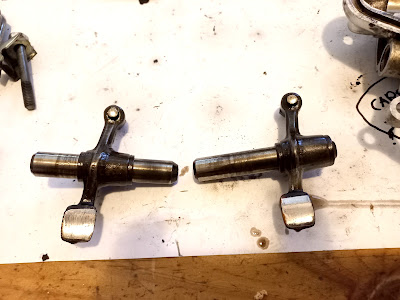 |
| Valve rocker arms Honda CB500K1 |
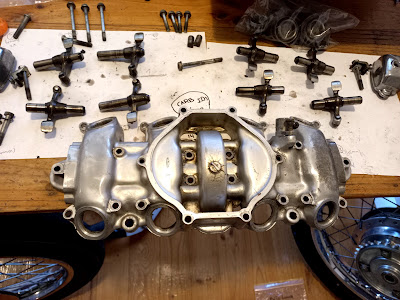 |
| Head cover parts Honda CB500K1 1972 |
I carefully tried to cut the glue loose with a razorblade and after some #$%! and beers the head cover finally separated from the head. You can remove the rocker arms and shafts by screwing a long 6mm bolt into the arm shaft and simply pull them out of the head cover.
After spraying WD40 on the cylinder head bolts for a couple of days I removed the head and barrel. A lot of carbon build up but nothing too serious. The pistons didn't look too bad but two of them had their rings stuck in the ring lands because of the carbon. I took 'em out of the engine and tried to loosen them in a cup with WD40. But they were really stubborn.
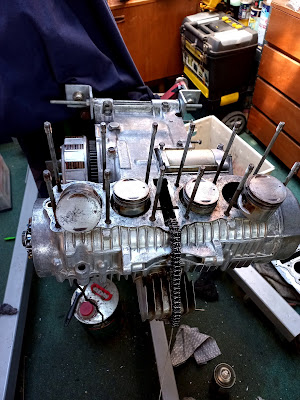 |
| Engine case with old pistons Honda CB500K1 1972 |
 |
| Old pistons with rings stuck in ringlands |
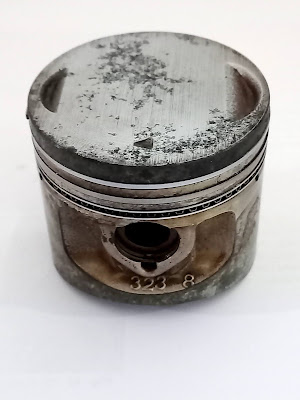 |
| Pitted original "Honda 323" piston |
All in all I decided to get new 0.25 oversize pistons and rings. Original Honda ones are very expensive but 4into1.com sells a nice set for under a $100,-
The 4 piston set replaces Honda Part Numbers: 13102-323-405 (piston), 13021-323-014 (rings), 94601-15000 (clip) and 13111-440-000 (pin)
When I got them I compared the dimensions and weight of the new ones with the original old Honda ones and was pretty pleased with the results... Same overall and individual weight for the pistons, piston pins and rings. With a lot of cheap imitation pistons sets the weight differs from the originals, sometimes the piston pin is too heavy or the piston too light. The new ones have one extra oil hole below the rings and behind the scraper rings compared to the original ones. I can't say anything about the quality of the forged aluminium as you simply can't tell by looking at them how they were forged.
Make sure the Letter stamped on the top two rings are facing up when
installing them and stagger the ring gaps according to the manual (90 degrees between each gap).
Ring order:
Top Compression Ring (silver outer rim)
Second Ring (black outer rim)
Bottom Rings (3 pieces - Spacer in the middle - 1 thin ring on either side)
 |
| Weight original piston Honda CB500K1 1972 |
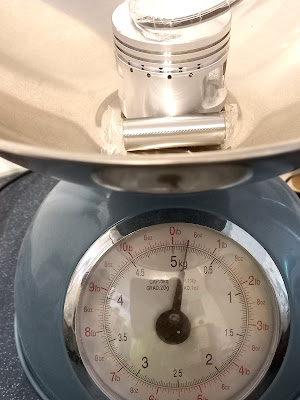 |
| Weight new piston |
 |
New piston with rings Honda CB500 four
|
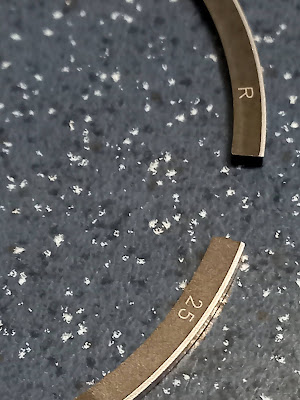 |
New 0.25 oversize piston ring Honda CB500 four
|
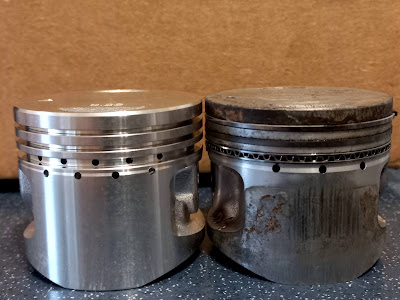 |
| New and old piston Honda CB500 four |
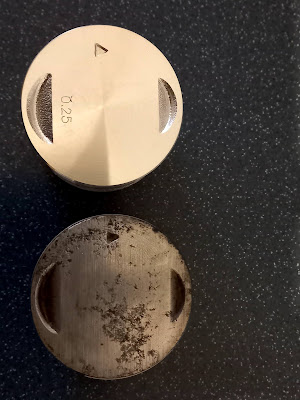 |
| New and old piston Honda CB500 four |
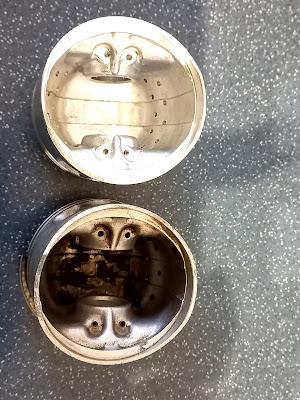 |
New and old piston Honda CB500K1 inside
|
 |
| Weight old piston Honda CB500 four |
 |
| Weight new piston Honda CB500 four | | |
I took the head, new pistons and cylinder to Sam at Chris Milton engines for an engine bath, vapor blast, rebore, hone, head skim and valve lapping. They also removed the bent valve without damaging the valve guide.
 |
| 0.25 oversize bore and hone Cylinder Honda CB500K1 |
 |
| honed surface Cylinder Honda CB500K1 |
Some Maths
I was curious what the new engine capacity would be with the 0.25 oversize pistons.
The formula to calculate the capacity of an engine:
Capacity (in cc) = (π/4 x bore² x stroke x # cylinders)/1000 (note: π ≈ 3.14)
Original engine: (3.14/4 x 56.0² x 50.6 x 4)/1000
≈ 498.2 cc
Rebuild engine with 0.25mm oversize pistons:
(3.14/4 x 56.25² x 50.6 x 4)/1000
≈ 502.7 cc
An increase of 4.5 cc !
 |
| Skimmed and vapor blasted Cylinder head Honda CB500K1 |
 |
| freshly cut valve seats Cylinder head Honda CB500K1 |
 |
| Cylinder head Honda CB500K1 |
 |
| Valve guide inside Cylinder head Honda CB500K1 |
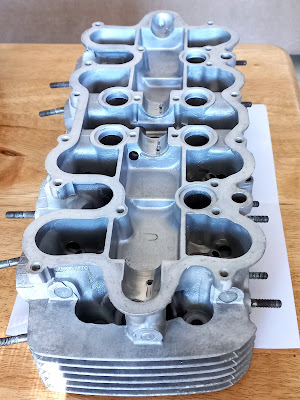 |
| Cylinder head Honda CB500K1 |
 |
| Lapped valves |
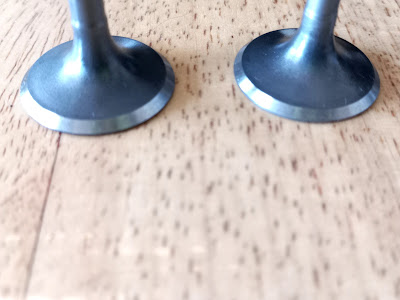 |
| Lapped valves |
After I picked everything up I painted the head cover, head and barrel with 3 coats of Dupli color D1615 aluminium engine paint with ceramic. This colour is almost an exact match with the original factory colour.
A good trick to get sharp masking tape edges is to rub the overhanging tape with a piece of metal like a spoon, it will cut the tape on the sharp edge and you can peel of the excess no worries.
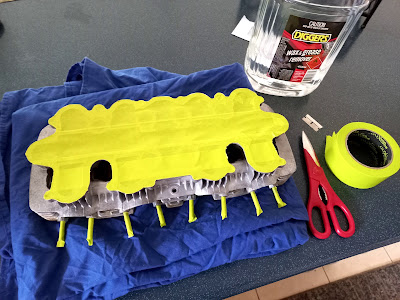 |
| Painting engine Honda CB500K 1972 |
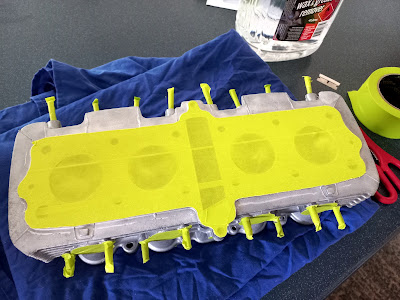 |
| Painting engine Honda CB500 |
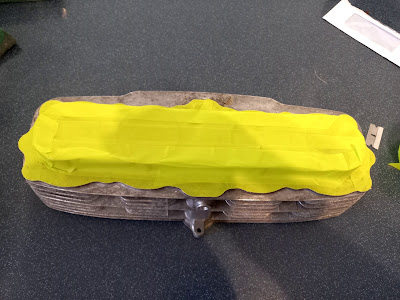 |
| Painting engine barrels |
 |
Painted engine head
|
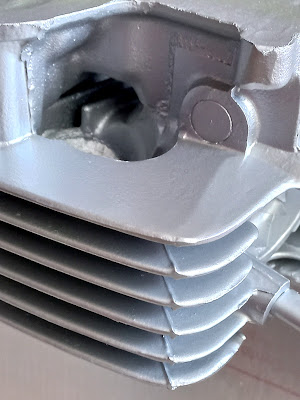 |
| Painted engine Honda with Dupli color D1615 |
 |
A bit more now with the 0.25 oversize pistons
|
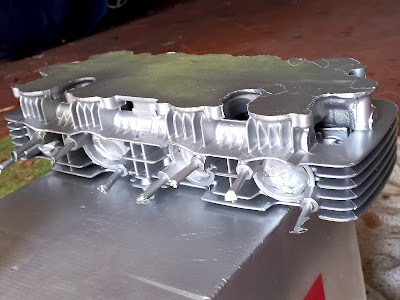 |
| Painted engine Head |
 |
| Painted engine barrels |
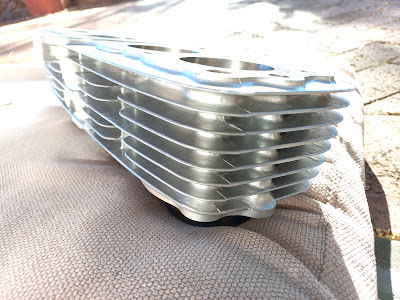 |
| Painted engine barrels Honda with Dupli color D1615 |
Before I painted the engine case it took me at least 15 hours of cleaning all the little corners with bamboo skewers, old socks, thinner, steelwool and wax and grease remover. I tried to only use wooden tools to remove grease and dirt so I wouldn't damage the soft aluminium. After that I sanded everything with grit 240 and 400 which is rough enough to give the paint something to bite in but smooth enough to give it an nice finish I'm happy with the results and hopefully the paint will stay on the engine for a long time and won't "yellow" (never use clearcoat because that will yellow for sure...)
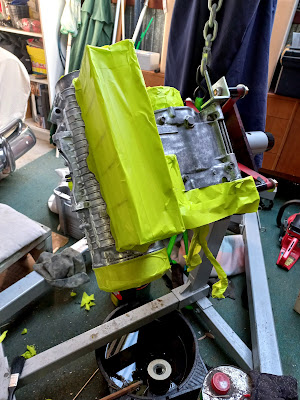 |
| Painting engine case Honda |
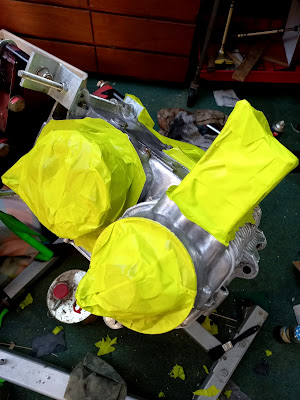 |
| Painting engine case HondaCB500K1 |
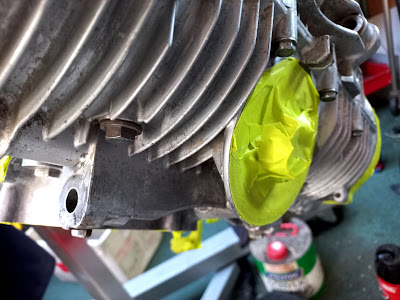 |
| Painting engine case Honda CB500 |
 |
| Painting engine case Honda with Dupli color D1615 |
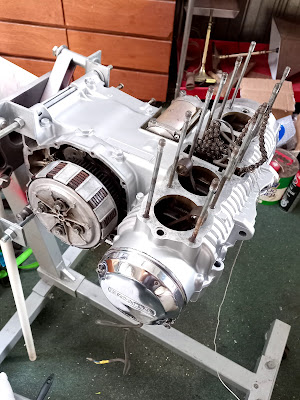 |
| Painted engine case Honda with Dupli color D1615 |
 |
| Painted engine case Honda |
 |
| Painted engine case Honda CB500K1 |
When I installed the new valve guide seals that came with the gasket set I noticed they were of poor quality, too soft, floppy and the tiny springs almost fell of without touching them, One of them even ripped while trying to install it. Luckily 4into1 sells also better quality ones for 1.50 each. Make sure you order them even when you buy the gasket set. The new ones were installed in seconds, they popped in place straight away.
 |
new valve seals crappy brown ones and better green ones
|
 |
new valve seals Honda CB400F, fits various models
|
 |
| new valve seals Honda CB500 four |
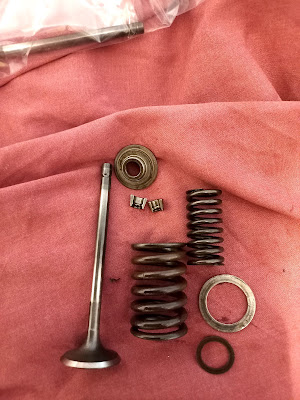 |
| Valve, springs, spring seats and collets |
The Honda CB500K1 has dubble valve (coil) springs which allow extremely
high RPM without valve float. It makes it a bit harder to install the
valve collets (talking from experience..)
The two "washers" are the seats for the valve springs and go between the head and springs.
 |
Sliding the valve into the valve guide
|
 |
Valve stem, spring seats and seal
|
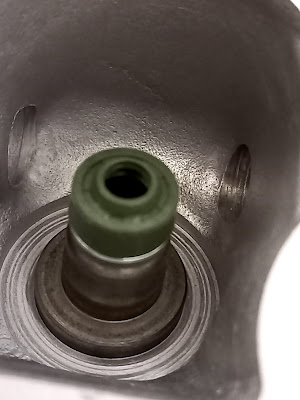 |
Valve stem seal installed on valve guide
|
As the cam chain tensioner was damaged (half of the adjusting screw had snapped off) I wanted to replace it and just out of precaution I decided to also replace the cam chain with a new one (Made in Japan - Brand: Enuma). And while there it made sense to me to also replace the cam chain guide, which can wear out and isn't too expensive to replace.
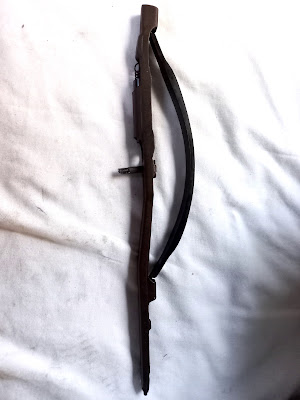 |
| Old cam chain tensioner Honda CB500K1 1972 |
 |
| Broken screw cam chain tensioner Honda CB500K1 1972 |
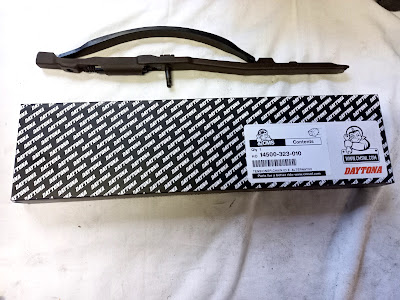 |
New cam chain tensioner CMSNL Honda CB500 four
|
 |
| Cam chain Enuma Honda CB500K1 1972 |
So on a Saturday afternoon two mates from work rocked up to help with changing the cam chain (Roger has a special tool to do this) and putting the barrels back on the pistons.
In exchange there was a reward after the job in the form of beer and popcorn (to be honest the first couple of beers were consumed before we even started the job ;).
First thing to do was replacing the cam chain, followed by fitting the new pistons. Make sure you cover the openings underneath the pistons with a rag so nothing can fall into the engine while installing the pistons.
And now it was time for the fiddly job of slipping the pistons into the barrels. With six hands it was done in a couple of minutes and everything moved nice and smooth.
 |
| Installing the new Enuma cam chain Honda CB500 four |
 |
| Installing the new 0.25 pistons Honda CB500K1 |
 |
| Preparing the new pistons, beer in the background |
 |
| Fitting the engine case/barrel gasket |
The engine case/barrel gasket should go on with the printed side faced up. In the pic it's upside down ;)
Don't forget to install the 4 new O-rings around the bottom of the cylinders and the 2 that go around the oil valves (oil control orifice) on the left and right side of the engine case.
 |
| Barrels installed Honda CB500K1 |
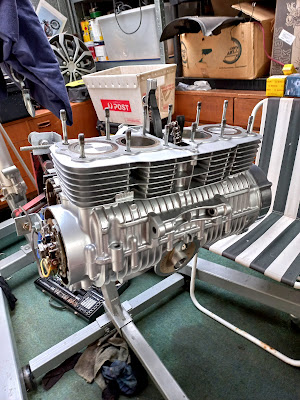 |
| Barrels installed Honda CB500K1 |
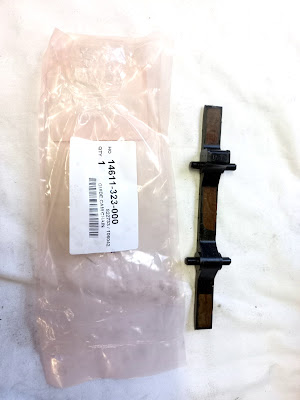 |
| Cam chain guide Honda CB500 four |
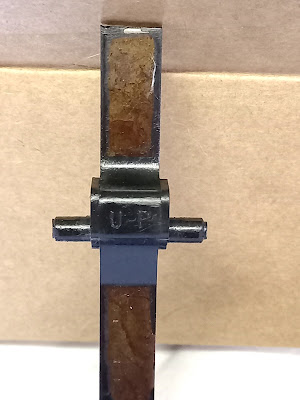 |
| Old cam chain guide "UP" mark Honda CB500 four |
 |
| Cam chain, tensioner and guide installed |
 |
| Cam chain tensioner adjusting screw Honda CB500K1 |
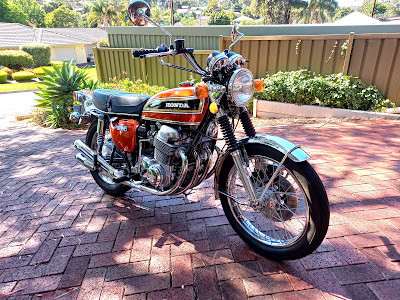 |
| Bonus pic of Shaine's Honda CB750K4 1974 |
It all took a bit longer than expected so we didn't put the head back on and I decided to finish it later on. The next day I got everything ready, put the new head gasket and two little O-rings in place, almost fitted the dowels (also called "knock pins") but ... Grrrr one of the dowels was slightly deformed (invisible with the naked eye..) during the disassembly and didn't wanna go into the barrel nor into the head with one side. I tried to tap it back in it's original shape but it didn't work and it actually streched the metal.
You really need those dowels to line the barrel and head up for an exact fit. So I ordered some new ones but it took around 2 weeks to get them.
So this morning I got up early while it was still nice and cool in the
shed and fitted the head. Before I fitted the head over the studs I made sure each new nut travelled smoothly over the stud. After that I fitted the new gasket, new knock pins and two little O-rings over the oil passages and carefully lowered the head over the studs onto the barrel.
 |
New head dowels
|
 |
Hew dowels Honda CB500K1
|
 |
| New head dowels Honda CB500K1 |
 |
| New stud flange bolts Honda CB500K1 |
 |
| Fitting cylinder head Honda CB500K1 |
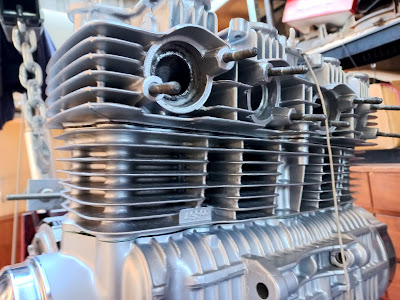 |
| Fitting cylinder head Honda CB500K1 |
Next I grabbed the thick washers with a circlip plier and fitted them on the studs. Make sure the flat side faces towards the head. The edge of the topside of the washer is a bit more rounded and it's easy to feel the difference. The new nuts were installed with the help of a magnet and torqued down to 22 Nm
(16 foot pound) in the sequence shown in the pic below.
 |
| Torque sequence Cylinder head Honda CB500 K1 1972 |
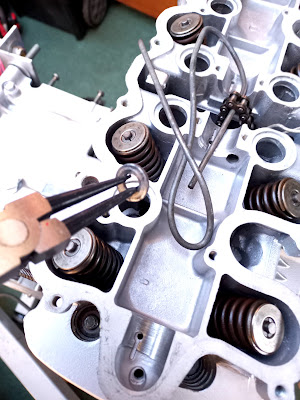 |
| Fitting the cylinder head washers |
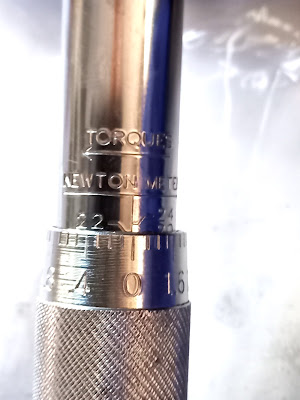 |
| Torque value 22Nm for the cylinder head nuts Honda Cb500 four |
 |
| New cylinder head nuts Honda Cb500 four |
Next step was fitting the cam underneath the cam chain and camchain over the
sprocket. Before putting the cam into it's right spot I applied some assembly lube on both mating sides of head and cam. Before you can fit the cam sprocket over the cam you have to adjust the valve timing. Rotate the crankshaft in clockwise direction and align the T (1,4) mark to the timing mark on the case. Now make sure them notch on the outer right side of the camshaft is aligned with the head surface (see pics below). It was a bit of a struggle to get the sprocket with camchain
back on the cam but with a thick piece of wire I managed to pull it high
enough so I could carefully tap it back in place with a rubber mallet.
Everything moves smoothly, the only worry I had is that the cam chain
appears to be very tight. It's a new camchain as mentioned earlier (Enuma EK29H) so I kind of expected a tighter fit. The cam sprocket bolts were torqued down to 16Nm and secured with a drop of Loctite 243.
 |
| Cam chain Honda CB500 K1 |
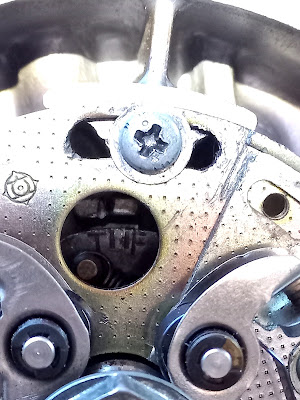 |
| Setting the correct valve timing Honda CB500K1 |
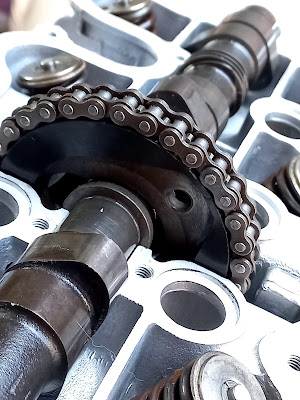 |
| Setting the correct valve timing |
 |
| Setting the correct valve timing Honda CB500 |
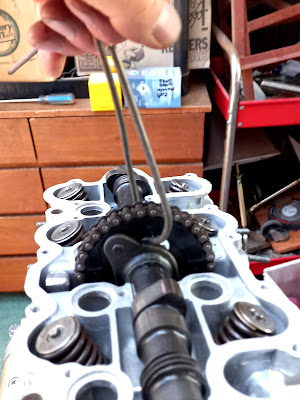 |
| Lifting the cam chain over the cam sprocket |
 |
| New Enuma cam chain Honda CB500K1 |
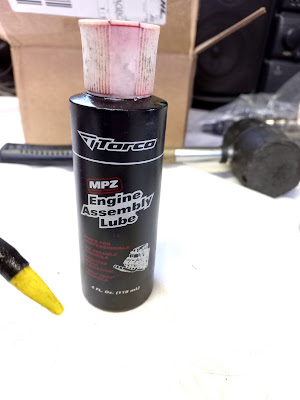 |
| Assembly lube |
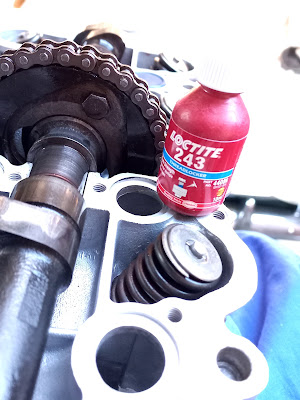 |
| Cam sprocket bolts secured with Loctite 243 |
The last step was putting the cam cover back on the head, There're a lot of bolts and screws involved. To minimalise the risk of bending tappets I used rubber bands while installing the cover. Unfortunately I don't have a pic of it but basically you connect opposite tappets by a rubber band so they stay as far away from the valve stems as possible.
To keep the rubber gasket in place during installation I used a couple of drops of clear glue.
 |
| New bolts and tappet covers Honda CB500 four |
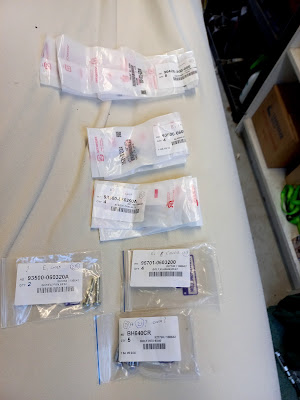 |
| New bolts head cover |
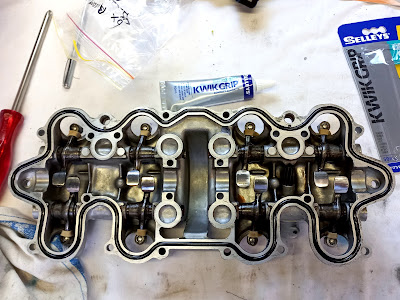 |
| New gasket head cover Honda CB500 four |
 |
| Fitting the cam cover Honda CB500K1 |
 |
| Fitting the cam cover |
I started with the middle four flanged bolts, just put them in, then working my way to the outside of the cover. Just hand tight them before you torque them down to specs.
I also cleaned the oil strainer, you can just pull it out after removing the oil pan.
 |
| Cleaned oil strainer Honda CB500K1 |
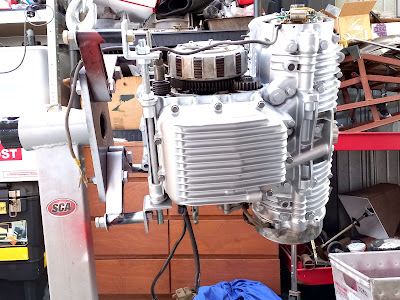 |
| Oil pan with new gasket fitted |
Last bit was bolting down the breather cover with some new bolts and screws, replacing some oil seals and adjust the valve clearance to spec (0.05mm inlet and 0.08mm for the outlet valves), easy job.
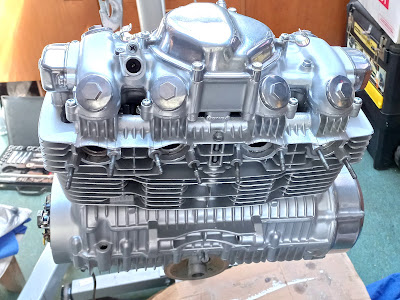 |
| Breather cover Honda CB500K1 |
 |
| Engine Honda CB500K1 |
 |
Feeler gauge for Honda fours
|
 |
| Engine Honda CB500K1 1972 |
 |
| New oil seals for tacho gear Honda CB500K1 |
Ok, what the heck, let's fit the engine back in the frame.as well.
The method I used was putting the engine on the right side and drop the frame over it.
It's easier to do this with two people but you can do it alone if you want.
Shaine had done this before with his old BMW bike and said it was the best and easiest way to do it.
So Shaine rocked up again and was followed by Lorrie who was touring around in the neighbourhood on his new Kwaka Z900 ..
 |
Nice bikes
|
The first step was taking the engine of the engine stand, easy job with 3 people. Next we wrapped bits of the freshly painted frame in bubble wrap and before we knew it the frame was lowered over the engine. We connected engine and frame with the bolts, hangers and nuts losely installed and lifted the lot on a heavy duty dolly normally used for my old welder.
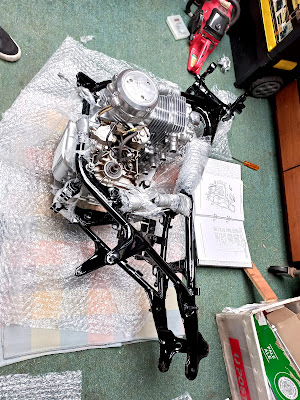 |
| Engine mated with frame Honda CB500K1 |
 |
Time for some beers
|
 |
On the dolly
|
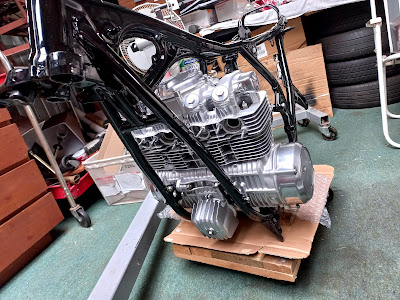 |
| Nice |
There you have it, the assembly can begin :)

































































































